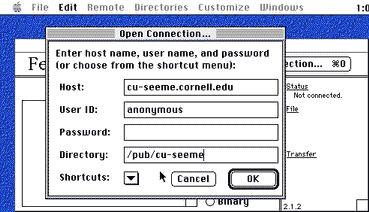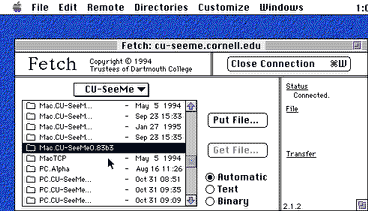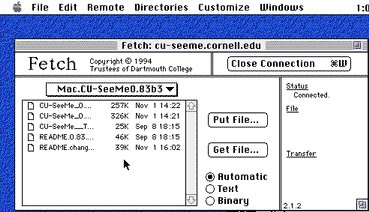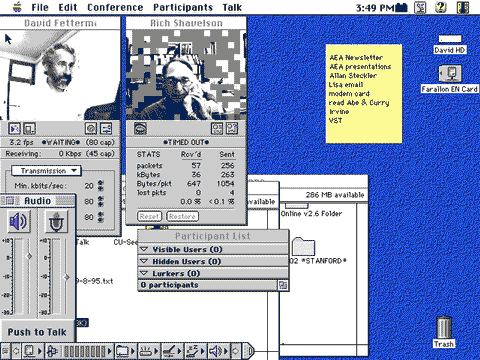
Videoconferencing technology allows geographically disparate parties
to see and hear each other--across campus or around the globe--usually through
satellite or telephone communication systems. It is typically an expensive
undertaking involving costly equipment, high user fees, and elaborate infrastructure,
often including a dedicated videoconferencing room. These costs and the
required preparations for a videoconference have limited the number of potential
users.
A developing new technology is now bringing videoconferencing within the
reach of faculty, students, and practitioners. Free or inexpensive software
programs are available that allow videoconferencing on-line over the Internet,
with no satellite or long-distance charges. With only this software and
a small, relatively inexpensive personal camera plugged directly into a
personal computer, individuals can videoconference through their computer
screen with any other similarly equipped users worldwide.
I use Internet videoconferencing to communicate with colleagues on campus
and throughout the world, to consult, and to teach. I have introduced this
tool to my Stanford students and used it in the classroom, as well as between
classes, to facilitate communication. Office hours are now possible from
a distance, when I'm traveling or when students are in distant locations.
In my on-line ethnography classes, Internet videoconferencing is enhancing
our educational experience, allowing a more immediate, more interactive
form of contact than e-mail. We plan to experiment with this tool in the
new evaluation program beginning at Stanford next year, to supplement classroom
activity, regular office hours, and seminars. We also plan to use it in
evaluation projects to conduct follow-up interviews and observations at
remote sites. Currently, I am preparing to present an evaluation workshop
from my office at Stanford, California, for the California State Department
of Education in Sacramento. This interactive medium thus is enabling me
to maintain my campus schedule of duties and appointments and avoid time
lost to travel.
Internet videoconferencing has other less tangible benefits as well. Electronic
communication is a little more personal and a lot more effective when you
can hear the nuances of tone and see nonverbal "language" such
as gestures and expressions, cues you normally depend on in face-to-face
interactions. Videoconferencing also enhances collegial communication, particularly
in preparation for professional association meetings and during multi-site
research projects. Illustrations, maps, book covers, and physical settings
can be shared instantaneously. The implications for international cooperation
are considerable. I am working with colleagues in South Africa to use Internet
videoconferencing to extend their empowerment evaluation program in association
with the Independent Development Trust's 1000 School Project.
A particularly useful and inexpensive videoconferencing set-up combines
CU-SeeMe software -- available in Mac and PC formats at no cost from Cornell
University (see below) and designed for Internet use--with a digitizer camera,
such as QuickCam by Connectix (cost: approximately $100). This is one of
the least expensive digitizer cameras on the market. It provides acceptable
black and white viewing -- with frame rates of up to 15 fps; transmitting
data through the serial port at 2 megabits a second.
Using this set-up, I have enjoyed simultaneous conversations with colleagues
in Stockholm, Seoul, New York, San Diego, and Tokyo. Icon buttons allow
the user to talk either privately with an individual or as a member of a
group videoconference "call." A picture of my computer screen
during one such videoconferencing sessions is provided below:

Many features common to videoconferencing software are worth exploring.
Video and audio interaction can be supplemented with written communication
in a talk window. One can e-mail brief, private messages to individual colleagues
during a group videoconference or present a written piece of text for group
comment. This feature is particularly useful when one is dialing up from
a modem at home (instead of connecting directly from an Internet Protocol
address in the office), where sound or voice is seriously degraded.
Another feature is image reversal. An icon reverses the picture you send,
which is particularly useful when connections go through a reflector site
that presents a mirror image. For example, I showed one colleague the flier
for my new book about empowerment evaluation. Once we found the reverse
image icon, my colleague was able to read the flier correctly.
An individual microphone icon, which allows private "side" conversations
during a group videoconference, is another useful feature. I sometimes use
this option to follow up on individual interests or suggest a course of
action without disrupting the flow of the discussion.
Setting up Internet videoconferencing is fairly simple. The software
is user friendly, and documentation for its use is available. In addition,
a visual guide for CU-SeeMe is available at the following Internet location:
http://www.jungle.com/msattler/sci-tech/comp/CU-SeeMe/users-guide/index.html
. A few basic instructions about use and generally available hardware and
software are all that most computer-literate users will need.
For a Macintosh computer, the basic set-up requires System 7 or higher,
a color monitor (or 16 shades of gray), an Internet Protocol network connection,
CU-SeeMe software, Apple's QuickTime software, and MacTCP 2.04 or higher
(a software program to connect to the Internet). The set-up for a PC is
similar and detailed in the CU-SeeMe folders described below. Using
Fetch or similar uploading and downloading software, you can download CU-SeeMe
software by using these commands: host: cu-seeme.cornell.edu; user ID: anonymous;
directory: /pub/cu-seeme. (See illustration below.)

Once inside the CU-SeeMe folder, select the most recent version of the software
and put the appropriate files on your hard disk. (See illustrations below.)


At this point, you need to plug your camera into your modem or printer
port and open up the software. You can go immediately to the reflector test
site to interact with other individuals using the software and learn more
about how to use the system, or connect to specific colleagues through their
Internet Protocol or IP address (colleages can get this from their systems
operator if they do not know it ). From this point on, you are videoconferencing!
The picture below shows my video conversation with Rich Shavelson, Dean
of the School of Education at Stanford University, to demonstrate the one-to-one
connection.

Videoconferencing over the net is an increasingly popular form of on-line
communication. The technology is still developing, however, and several
bugs still need to be worked out. The software options are beta versions,
still in the testing mode and thus not compatible with every system. Communication
is not completely fluid: because of small lags in time, conversational protocols
are needed to signal when each person is finished speaking--much as they
do over CB radio. Such signals can be a simple as "what are your thoughts"
or even "over", and are particularly useful during multiple-user
videoconferences. One session with seven colleagues resembled a fast video
arcade game, as I tried to respond quickly to seven simultaneous exchanges.
Another drawback is that videoconferencing is more invasive than simple
electronic exchanges. It is easy to forget, as you work on your computer
in the privacy of your home or office, that you are on display, often for
long periods of time. You learn the hard way to be attentive to any unconscious
mannerism, habits, or behaviors--twirling your hair, stroking your beard,
and so on. This level of interaction is not comfortable at all times and
for all people.
A problem that needs to be addressed at the software level is the difficulty
of connecting Macintosh and DOS-based systems. I have had no difficulty
linking machines with the same Macintosh operating systems and software
connections to the Internet. Efforts to establish links between different
systems have had some problems, however. For example, Leonard Bickman, current
president of the American Evaluation Association, and I have been using
CU-SeeMe to facilitate association activity. I have a Macintosh; Len has
a DOS-based system. During our first attempt to use this approach, we were
able to see each other immediately and Len could hear me, but I was not
able to hear him. He had to use the "Chat" window to communicate
with me -- typing his messages to me in real time, while I spoke to him
through my internal microphone.
Another colleague and a co-editor, Abraham Wandersman from the University
of South Carolina, had a systems network problem that initially prevented
us from communicating -- a problem unrelated to the software, the machines,
or the camera. We have since worked this out, and I will be guest lecturing
in his classroom in South Carolina from my office this quarter, discussing
our new book about empowerment evaluation.
Consulting on a one-to-one basis is reasonably straightforward. Workshops
or demonstrations for large numbers of people can be engaging and sensitive
to individual concerns and interactions--when everything operates correctly.
However, such situations present their own challenges. To conduct a workshop,
for example, the set-up is simple on my end: I have a camera attached to
my computer in my office, and my computer is linked to the Internet. My
colleagues at the other end of the line need in addition an LCD panel connected
to the computer and resting on top of a high-intensity overhead projector.
This set-up projects my larger-than-life image on the screen, enabling workshop
participants to see me clearly. Added connections always increase the potential
for problems, however. The computer line can be interrupted or disturbed
during the workshop or demonstration; the LCD panel may not be compatible
with the group's computer; the room may not be dark enough to see the image;
and so on. Any one of these problems can render the videoconferencing exchange
worthless. In addition, workshop participants generally must come up to
the camera so that I can see and hear them clearly. The potential for disrupting
the flow of a workshop is minimized by having a facilitator (and LCD panels)
at both ends, but these adaptations require forethought and preparation.
The modem speed and type of Internet line connection are other sources of
potential difficulties. CU-SeeMe software, for example, requires a 28.8
modem for spoken communications. Internet line connections such as
T1, ISDN, or fiber optics are highly recommended for acceptable quality
transmissions.
Finally, videoconferencing's greatest value--immediacy--is also its most
significant drawback. Asynchronous communication allows people to communicate
despite differences in schedule and time zone. Videoconferencing of any
sort requires that participants coordinate their schedules. Global videoconferencing
thus has limited convenience for participants in widely different time zones.
Internet videoconferencing is a powerful medium, but without a clear connection
it can be as bumpy as the most pothole-riddled sections of the information
highway. Its potential is immense, and its capabilities worth exploring.
As with all emerging computer technologies, an awareness that glitches and
beta testing are the norm initially and a willingness to work through these
difficulties can save much frustration and disappointment.
Internet videoconferencing can enhance electronic exchanges and expand
our reach and our accessibility worldwide. As is the case with most developing
technologies, glitches remain, although recent breakthroughs in data compression
may resolve the most serious problems. Videoconferencing on-line is rapidly
coming of age as an additional communication medium--particularly in situations
where travel is prohibitive. This new interactional technology can enhance
collegial communication and stimulate new applications and avenues of educational
exploration.
Fetterman, D.M. (1989). Ethnography: Step by Step . Thousand Oaks,
CA: Sage.
Fetterman, D.M., Kaftarian, S.J., and Wandersman, A. (1995). (Eds.) Empowerment
Evaluation: Knowledge and Tools for Self-assessment and Accountability.
Thousand Oaks, CA: Sage.
Michael Sattler's (1995) Internet TV with CU-SeeMe . New York: Sams.net
(Macmillian).
National Academy of Sciences and the National Academy of Engineering (1995)
Reinventing Schools: The Technology is Now! http://www.nas.edu/nap/online/techgap/welcome.html